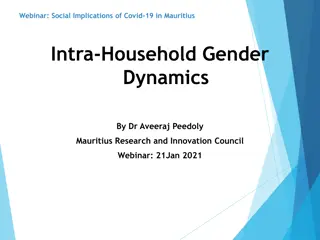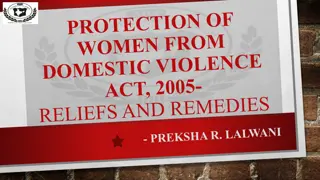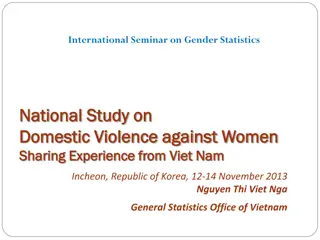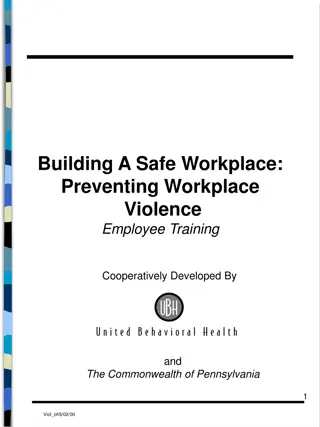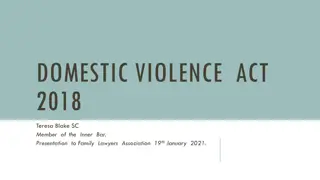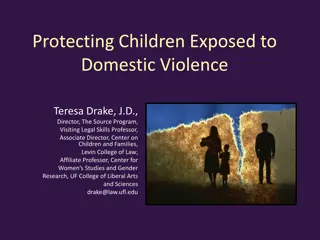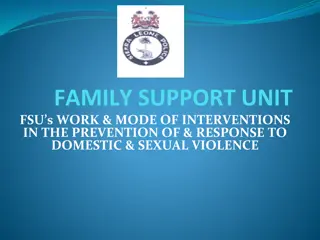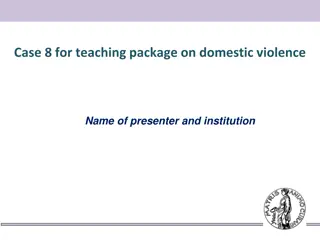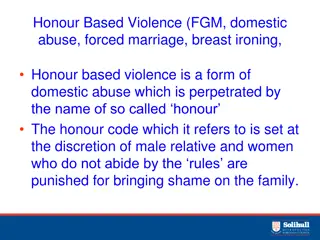Understanding Marriage Dynamics and Domestic Violence Statistics
Explore the various types of marriages, marriage statistics, and insights into domestic violence, including the cycle of violence, intimate partner violence rates, and racial statistics. Gain awareness of the different patterns within marriages and the significant impact of domestic abuse on individuals and relationships.
Download Presentation

Please find below an Image/Link to download the presentation.
The content on the website is provided AS IS for your information and personal use only. It may not be sold, licensed, or shared on other websites without obtaining consent from the author. Download presentation by click this link. If you encounter any issues during the download, it is possible that the publisher has removed the file from their server.
E N D
Presentation Transcript
Unit 5 Marriage, Communication, Lying & Cheating
5 Types of Marriages Total: 10 years or more -Both partners have high self-esteem and contribute equally to the relationship Vital: Less than 10 years Conflict Habituated: A relationship characterized by fighting Passive Congenial: A relationship in which the 2 people stay together for convenience Devitalized: Was once strong but is no longer so
Marriage Statistics 50% of all marriages stay together and 50% do not The order of marriage success is 1,3,2 The three most common reasons for divorce are: children, sexual issues (affairs), money
Domestic Violence 60% of all couples experience some form of domestic abuse. DV is 50% female to male and 50% male to female 95% of DV serious damage is male to female Woman are more likely to be injured or killed by a boyfriend, husband or ex than anyone else in life. Cycle of Violence: Honeymoon, Tension, Abuse, Regret
Cycle of Violence Honeymoon: Everything is pleasant Tension: The anxiety and anger builds Abuse: One strikes the other Regret/Sorrow: The apologies & promises occur
Intimate Partner Violence Experiencing rape, physical violence, and/or stalking by an intimate partner in their lifetime. 1 in 3 women and 1 in 4 men have experienced IPV in their lifetime.
Ages of IPV 70% of females and 55% of males who are victims of IPV experience it before age 25. 22% of females and 15% of males experience IPV for the first time between ages 11 & 17. 47% of females and 39% of males were between 18 & 24 when first experiencing IPV.
Racial Statistics of IPV 40% Black women; 38% Black men 35% White women; 28% White men 37% Hispanic women; 26% Hispanic men 20% Asian women; Unreported Asian men
IPV Sexual Orientation 44% lesbian women 61% bisexual women 35% heterosexual women 26% gay men 37% bisexual men 29% heterosexual men
Sexual Orientation Contd LGBTQ people are almost twice as likely to experience IPV as non-LGBTQ Bisexual people are nearly twice as likely to experience IPV as gay or lesbian individuals Transgender people are at much higher risk for IPV and sexual violence than non- transgender people. Also more likely to face threats, intimidation, harassment, and police violence.
Gaslighting A technique in which a person, in order to gain more power, makes a victim question their reality. There are 11 techniques which are used.
Telling Blatant Lies You know it's an outright lie. Yet they are telling you this lie with a straight face. Why are they so blatant? Because they're setting up a precedent. Once they tell you a huge lie, you're not sure if anything they say is true. Keeping you unsteady and off-kilter is the goal.
Denying Something was Said You know they said they would do something; you know you heard it. But they out and out deny it. It makes you start questioning your reality maybe they never said that thing. And the more they do this, the more you question your reality and start accepting theirs.
Using What is Near as Ammunition They know how important your kids are to you, and they know how important your identity is to you. So those may be one of the first things they attack. If you have kids, they tell you that you should not have had those children. They will tell you'd be a worthy person if only you didn't have a long list of negative traits. They attack the foundation of your being.
Wear Down Over Time This is one of the insidious things about gaslighting it is done gradually, over time. A lie here, a lie there, a snide comment every so often...and then it starts ramping up. Even the brightest, most self-aware people can be sucked into gaslighting it is that effective. It's the "frog in the frying pan" analogy: The heat is turned up slowly, so the frog never realizes what's happening to it.
Actions Dont Match Words When dealing with a person or entity that gaslights, look at what they are doing rather than what they are saying. What they are saying means nothing; it is just talk. What they are doing is the issue.
Use of Occasional PR This person or entity that is cutting you down, telling you that you don't have value, is now praising you for something you did. This adds an additional sense of uneasiness. You think, "Well maybe they aren't so bad." Yes, they are. This is a calculated attempt to keep you off-kilter and again, to question your reality. Also look at what you were praised for; it is probably something that served the gaslighter.
Using Confusion to Weaken People Gaslighters know that people like having a sense of stability and normalcy. Their goal is to uproot this and make you constantly question everything. And humans' natural tendency is to look to the person or entity that will help you feel more stable and that happens to be the gaslighter.
Projection They are a drug user or a cheater, yet they are constantly accusing you of that. This is done so often that you start trying to defend yourself, and are distracted from the gaslighter's own behavior.
Aligning Others Against Victim Gaslighters are masters at manipulating and finding the people they know will stand by them no matter what and they use these people against you. They will make comments such as, "This person knows that you're not right," or "This person knows you're useless too." Keep in mind it does not mean that these people actually said these things. A gaslighter is a constant liar. When the gaslighter uses this tactic it makes you feel like you don't know who to trust or turn to and that leads you right back to the gaslighter. And that's exactly what they want: Isolation gives them more control.
Tell Victim or Others - Crazy This is one of the most effective tools of the gaslighter, because it's dismissive. The gaslighter knows if they question your sanity, people will not believe you when you tell them the gaslighter is abusive or out-of- control. It's a master technique.
Tell Victim Everyone Else is a Liar By telling you that everyone else (your family, the media) is a liar, it again makes you question your reality. You've never known someone with the audacity to do this, so they must be telling the truth, right? No. It's a manipulation technique. It makes people turn to the gaslighter for the "correct" information which isn't correct information at all. The more you are aware of these techniques, the quicker you can identify them and avoid falling into the gaslighter's trap.
Leaving Leaving an abusive partner may be the most dangerous time in a relationship Women are 70 times more likely to be killed in the weeks after leaving their abusive partner than any other time in the relationship. It takes a victim an average of 7 times to leave an abusive relationship before the separation is final. Prior non-fatal strangulation is associated with 7.5 times of becoming a completed homicide.
Negative Communication Styles Placator: Makes the person feel better at all costs, even above their own self-worth Blamer: Puts responsibility on other person Distractor: Cannot stay focused on conversation at hand Moralizer: Brings religion into every conversation Sarcasm: Puts others down by ridiculing Know-it-All: Shows off knowledge to make others feel inferior
Healthy Communication Leveler: Open, honest communication sharing real feelings and not hiding from partner Healthy communication is the #1 factor in keeping relationships strong and people staying together.
3 Stages of Morality Preconventional (5-10): Avoidance of consequence and gaining of rewards Conventional (11-15): Follows the law and peers Postconventional (16 - ): Follows one s own morals and benefits society
Lying & Cheating Children first learn to lie at age 2 3. 70% of these children lie well, but can t hide emotion By age 5, 95% of children lie well but still can t hide emotion By age 8, 99% of children lie well and can hide emotion 100% of children who cheated on a test, lied about it 40% of young adults lied on a resume to get a job 40% of students cheat on a regular basis 60% of students cheat when a prize is offered Men lie for personal gain whereas woman lie to help people feel better.
Why Students Cheat Pressure to succeed Fear of failure Lack of morality Lack of thought of consequence Desire for immediate gratification
Compulsive Lying Compulsive Liar: Lies and knows they are lying. Pathological Liar: Lies and believes their own lies.
Parenting Styles Authoritarian (Autocratic): Dictator, Do as I say, Inflexible; Likely to raise angrier, rebellious, or overcontrolled children Permissive (Laissez Faire): Allows kids to get away with everything; Allows kids to walk all over them. Kids are more often out of control Authoritative (Democratic): Best of parenting styles. Has firm but fair ways about them.
DV Essay Discuss the importance of healthy relationships and the dangers of domestic violence. Explain the clues of a DV relationship and the clues of an individual who is dangerous. Finally, explain the best ways to avoid a DV relationship or how to get out of one if in one.







